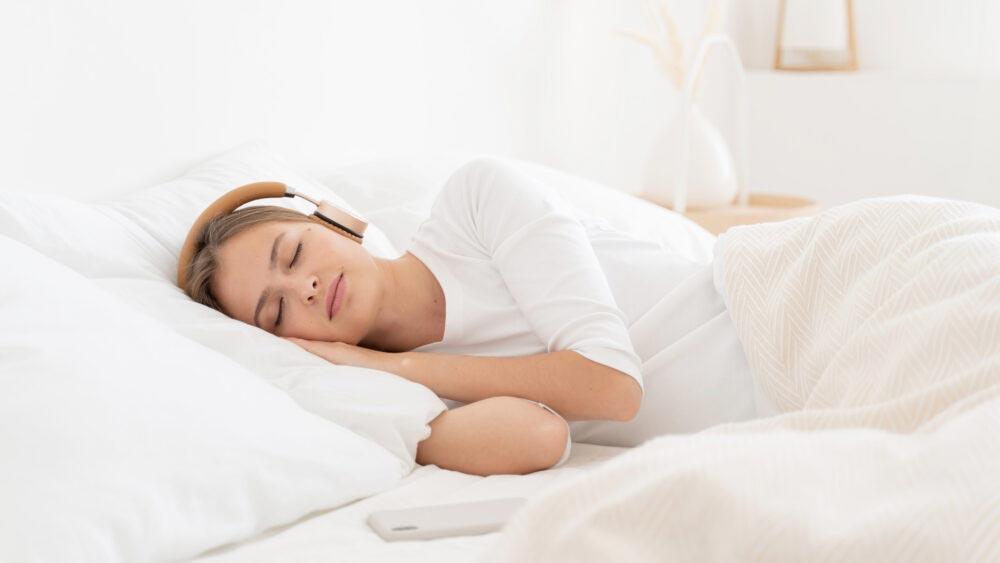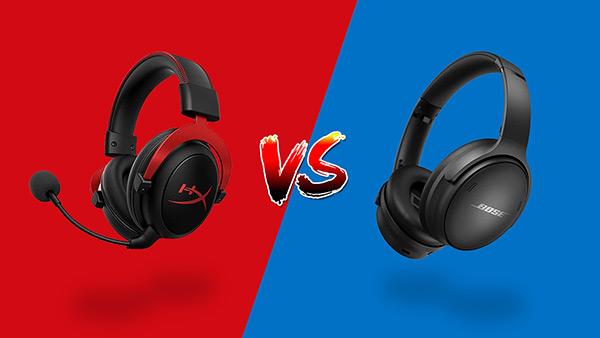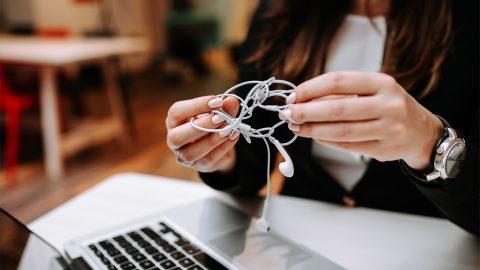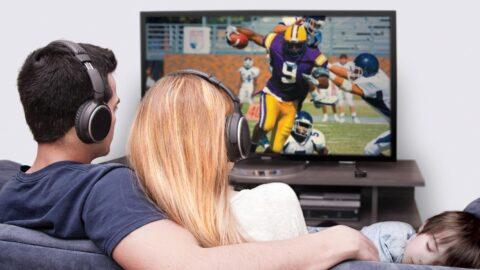Sleeping With Headphones: Everything You Need To Know

After a stressful day, most people have a hard time falling asleep. Sleeping with headphones on has become a common way to tune out a long day. Have you ever asked yourself, is it safe to sleep with headphones or earbuds on?
While there’s nothing wrong with using headphones to unwind before bed, sleeping with them on can present many concerns. However, there are several ways to safely wear headphones in bed to help you relax and fall asleep faster.
Is It Safe to Sleep with Headphones or Earbuds On?
Falling asleep with headphones or earbuds on can be safe when used correctly. While injuries related to falling asleep with headphones or earbuds are uncommon, you should know the risks vs. benefits. Here are some ways sleeping with headphones or earbuds can harm your health or benefit your sleep.
Risks of Sleeping with Headphones On
When you fall asleep with headphones, you run the risk of hearing loss, impacted earwax, choking hazards, and strangulation from cables close to your neck as you toss and turn at night.
Hearing Loss – Noise-induced hearing loss can occur if you use headphones for an extended period or play music loudly. Earbuds pose an even greater risk because they play sound directly into your ear canal. Excessively loud sounds can rupture your eardrums, resulting in hearing loss.
Impacted Earwax – In-ear headphones and earbuds can increase earwax build-up with excessive use. Since our ears naturally clean themselves, headphones can trap earwax that our ears would otherwise expel. When too much earwax collects in your ears, it can become impacted. Impacted earwax can result in earaches, ringing in the ears, and hearing loss.
Choking Hazard – Small items like earbuds can pose a choking risk when you fall asleep. You can accidentally swallow wireless earbuds or in-ear headphones while you sleep. Because wireless earbuds are small and contoured to fit within an ear canal, they can fall inside of your mouth and become caught in your esophagus as you sleep.
Strangulation Hazard – Wired headphones can become wrapped around your throat while you sleep. If you toss and turn at night, long headphone cables may tangle and wrap around your neck, blocking or greatly restricting your airway.
Benefits of Sleeping with Headphones On
Now that you know the risks of sleeping with headphones, let’s go over some of the benefits. There are many beneficial reasons for wanting to sleep with headphones on. Headphones help you fall asleep fast, tune out the noise, and aid in relaxation after a stressful day.
Fall Asleep Faster – Headphones don’t have screens like TV or other devices that produce blue light, reduce melatonin and interrupt your sleep. Listening to your favorite songs, audiobook, or podcast at a low volume, can help you drift off a lot faster than watching your favorite series, movie, or YouTube channel on TV or mobile device.
Noise Reduction – If your having trouble falling asleep at night because of loud noises, noise-cancelling headphones can help. These headphones capture ambient sounds from the outside and then neutralize them before you hear them on the inside. Listening to music using noise-cancelling headphones can help to reduce outside sounds from next-door neighbors and nearby traffic so that you can get a more restful sleep.
Relaxation – Listening to white noise, nature sounds, and relaxing music on your headphones can help you fall asleep faster and sleep longer. The benefits of listening to relaxing music as you sleep are based on evidence. One study found 45 minutes of relaxing music improved sleep quality for adults before bedtime. When using headphones to fall asleep, find a volume level that is calming and tranquil.
How to Sleep Comfortably With Headphones On
It’s difficult to lay in bed with headphones on whether you sleep on your back, side, or stomach. Finding a position that keeps your headphones or earbuds from being painfully pressed against your ears can be challenging. Sure, you can sleep on your back, but that position can be inconvenient if you want to watch TV or sleep on your side. The answer is not finding the best sleeping position but using the correct headphones or pillow.
Headband Headphones
Headband headphones are wireless headband-style ear speakers designed to help you sleep. They’re usually worn around the forehead and completely cover the ears. These headphones use thin, flat speakers layered with foam to not hurt the ears. They typically use thin breathable material that allows your body to regulate its temperature as you sleep.
Thin Headphones
Thin headphones are ultra-thin headphones that are lightweight. Foam surrounds the speakers, adding comfort and preventing them from shifting. These headphones are designed with two thin, flat speakers that rest gently on your ears. They are ideal for side sleepers who like to listen to music and watch TV or mobile devices before falling asleep.
Pillow Speakers
Pillow speakers are devices that allow you to play music or sounds from under your pillow or another location. They work by connecting to a mobile device or MP3 player with a 3.5 mm headphone jack. Pillow speakers are ideal for listeners who have chosen not to wear headphones to bed but want to listen to music or nature sounds without disturbing others.
Travel Pillows
Travel pillows are horseshoe-shaped pillows that fit around your neck. They’re often used to keep the neck straight while sitting in vehicles when traveling. For most people, travel pillows are the ideal solution to the challenges of sleeping with headphones on. All headphones and earbuds fit nicely in the empty center of travel pillows. These kinds of pillows prevent your headphones or earbuds from pressing uncomfortably against your ears. Travel pillows are often available in various options, including memory foam, inflatable, foldable and machine-washable.
Best Headphones for Sleeping
The best headphones for sleeping have an ultra-thin profile, help to reduce outside noise, and are designed for comfort so that you can focus on getting a good night’s sleep. Here are the best headphones for sleeping:
- AcousticSheep SleepPhones Wireless
- Hoomband Headband
- Moita Sleep Headphones
- Fulext Sleep Headphones
- Lavince Sleep Headphones Headband
Conclusion
In conclusion, falling asleep with headphones can be safe when appropriately used. While it’s unlikely that anything harmful will happen, you should be aware of the dangers of sleeping with headphones on. You run the risk of hearing loss, excessive earwax, choking, and more.
Still, there are various reasons why headphones can contribute to a good night’s sleep. They help listeners fall asleep faster, reduce noise, and aid in relaxation after a stressful day.
If your headphones press against your ears at night, headband headphones, ultra-thin headphones, pillow speakers, and travel pillows can solve the problem. Headband and ultra-thin headphones are the best types of headphones for sleeping. They’re comfortable, designed with thin flat speakers, and block out outside noise.






